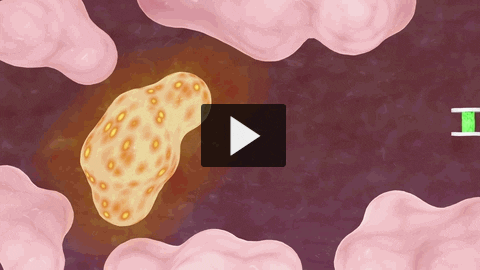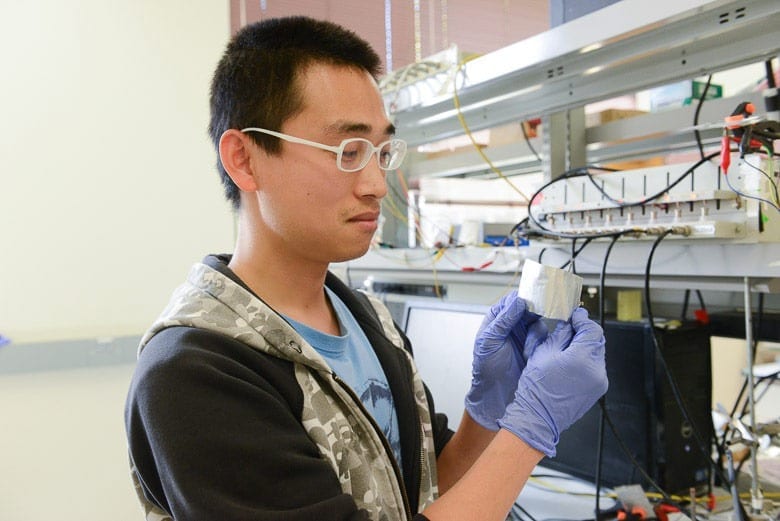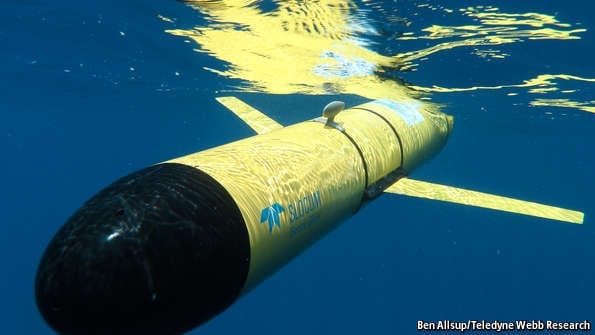
Scientists working at the National Institute of Standards and Technology (NIST) and the National Institutes of Health (NIH) have devised and demonstrated a new, shape-shifting probe, about one-hundredth as wide as a human hair, which is capable of sensitive, high-resolution remote biological sensing that is not possible with current technology. If eventually put into widespread use, the design could have a major impact on research in medicine, chemistry, biology and engineering. Ultimately, it might be used in clinical diagnostics.
To date, most efforts to image highly localized biochemical conditions such as abnormal pH* and ion concentration—critical markers for many disorders—rely on various nanosensors that are probed using light at optical frequencies. But the sensitivity and resolution of the resulting optical signals decrease rapidly with increasing depth into the body. That has limited most applications to less obscured, more optically accessible regions.
The new shape-shifting probe devices, described online in the journal Nature,** are not subject to those limitations. They make it possible to detect and measure localized conditions on the molecular scale deep within tissues, and to observe how they change in real time.
“Our design is based on completely different operating principles,” says NIST’s Gary Zabow, who led the research with NIH colleagues Stephen Dodd and Alan Koretsky. “Instead of optically based sensing, the shape-changing probes are designed to operate in the radio frequency (RF) spectrum, specifically to be detectable with standard nuclear magnetic resonance (NMR) or magnetic resonance imaging (MRI) equipment. In these RF ranges, signals are, for example, not appreciably weakened by intervening biological materials.”
As a result, they can get strong, distinctive signals from very small dimensions at substantial depths or in other locations impossible to probe with optically based sensors.
The novel devices, called geometrically encoded magnetic sensors (GEMs), are microengineered metal-gel sandwiches about 5 to 10 times smaller than a single red blood cell, one of the smallest human cells. Each consists of two separate magnetic disks that range from 0.5 to 2 micrometers (millionths of a meter) in diameter and are just tens of nanometers (billionths of a meter) thick. (See animation.)
Between the disks is a spacer layer of hydrogel,*** a polymer network that can absorb water and expand significantly; the amount of expansion depends on the chemical properties of the gel and the environment around it. Conversely, it can also shrink in response to changing local conditions. Swelling or shrinking of the gel changes the distance (and hence, the magnetic field strength) between the two disks, and that, in turn, changes the frequency at which the protons in water molecules around and inside the gel resonate in response to radio-frequency radiation. Scanning the sample with a range of frequencies quickly identifies the current shape of the nanoprobes, effectively measuring the remote conditions through the changes in resonance frequencies caused by the shape-changing agents.
In the experiments reported in Nature, the scientists tested the sensors in solutions of varying pH, in solutions with ion concentration gradients, and in a liquid growth medium containing living canine kidney cells as their metabolism went from normal to nonfunctional in the absence of oxygen. That phenomenon caused the growth medium to acidify, and the change over time was sensed by the GEMs and recorded through real-time shifting in resonant frequencies. Even for the un-optimized, first-generation probes used, the frequency shifts resulting from changes in pH were easily resolvable and orders of magnitude larger than any equivalent frequency shifting observed through traditional magnetic resonance spectroscopy approaches.
Tracking highly localized pH values in living organisms can be difficult. (A blood test cannot necessarily do it because the sample mixes blood from numerous locations.) Yet local pH changes can provide invaluable early signals of many pathologies. For example, the pH around a cancer cell is slightly lower than normal, and internal inflammation generally leads to local change in pH level. Detecting such changes might reveal, for example, the presence of an unseen tumor or show whether an infection has developed around a surgical implant.
Read more: Shape-Shifting Sensor Can Report Conditions from Deep in the Body
The Latest on: Geometrically encoded magnetic sensors
[google_news title=”” keyword=”Geometrically encoded magnetic sensors” num_posts=”10″ blurb_length=”0″ show_thumb=”left”]
via Google News
The Latest on: Geometrically encoded magnetic sensors
- How evolution has optimized the magnetic sensor in birdson April 24, 2024 at 10:22 am
Migratory birds are able to navigate and orientate with astonishing accuracy using various mechanisms, including a magnetic compass ... 4 functions as a sensor protein. Continue reading The ...
- How evolution has optimised the magnetic sensor in birdson April 24, 2024 at 8:09 am
The magnetic sense of migratory birds is probably ... A possible explanation is that cryptochrome 4 acts as a sensor protein. The study was published in the journal Proceedings B of the Royal ...
- Magnetic Sensor Market The Frontier of Knowledge Unraveling Mysteries through Uncharted Territory Techniqueson April 22, 2024 at 1:13 am
report_id=AMR758 Magnetic Sensor Market size was valued at $2.21 billion in 2018, and is projected to reach $4.22 billion by 2026, registering a CAGR of 6.9% from 2019 to 2026. Magnetic sensor ...
- 5 best metal detector apps for Android that actually workon April 17, 2024 at 5:00 pm
Metal Detector by ExaMobile is an Android app that utilizes your device’s magnetic sensor to measure magnetic fields accurately. This app lets you track field values over time with intuitive graphs.
- 5 best compass apps for Androidon April 17, 2024 at 5:00 pm
In addition, the app includes true and magnetic north headings, a magnetic strength meter, a slope level meter, and sensor status. This developer specifically asks that you not use magnetic covers ...
- Magnetic Proximity Sensors Informationon July 10, 2022 at 1:13 pm
Proximity sensing is the technique of detecting the presence or absence of an object using a critical distance. Magnetic proximity sensors are non-contact proximity devices that are used to detect ...
- A Magnetic Field Strength Meter Using An Arduinoon April 4, 2021 at 7:42 pm
It’s something [mircemk] demonstrates, with an Arduino-powered magnetic field strength meter that uses a UGN 3503U Hall effect device. The circuit is extremely simple, comprising the sensor ...
- Magnetic Angle Sensor Mods Make Encoder Better For Blastingon March 4, 2021 at 6:52 pm
The magnetic angle sensor has 14 bits of resolution, and with a small neodymium ring magnet glued to the bottom of the original shaft, the modified encoder offers far greater resolution than the ...
- Magnetic Field Sensors Informationon February 8, 2018 at 3:21 pm
Magnetic field sensors are used to measure magnetic flux and/or the strength and direction of a magnetic field. They are used mainly in scientific measurement, navigation, and industrial applications.
via Bing News









